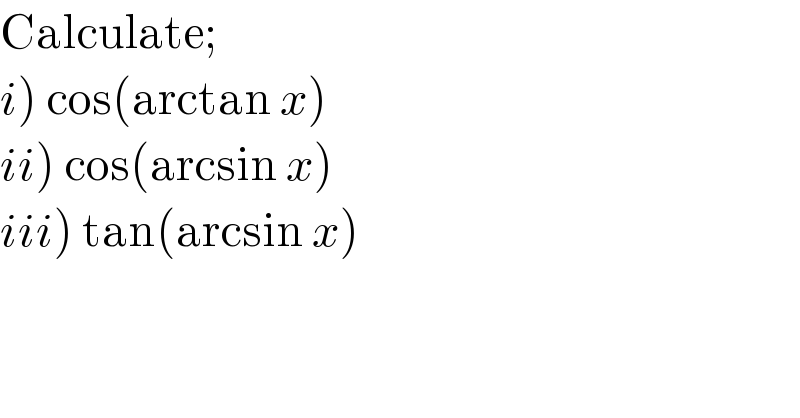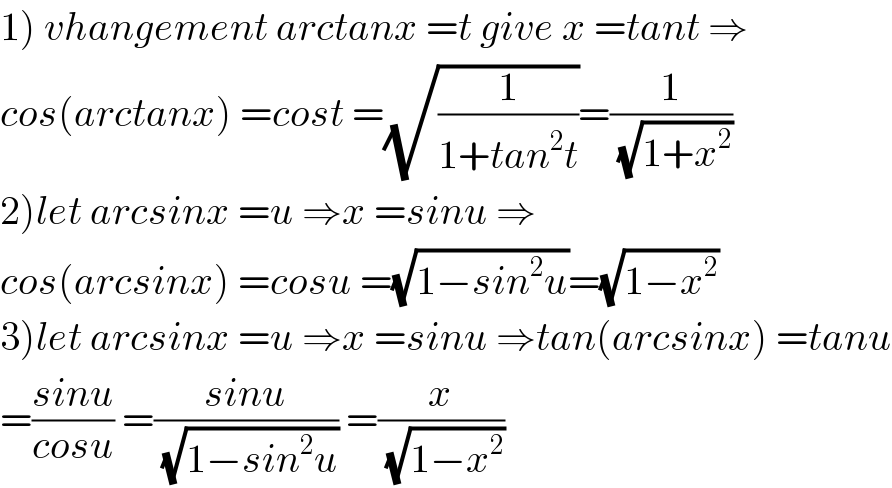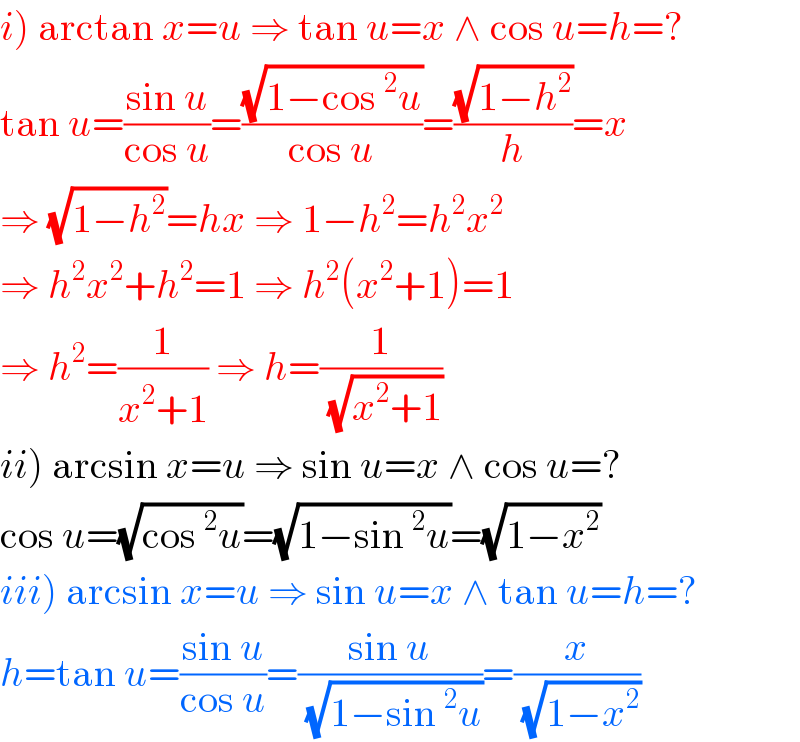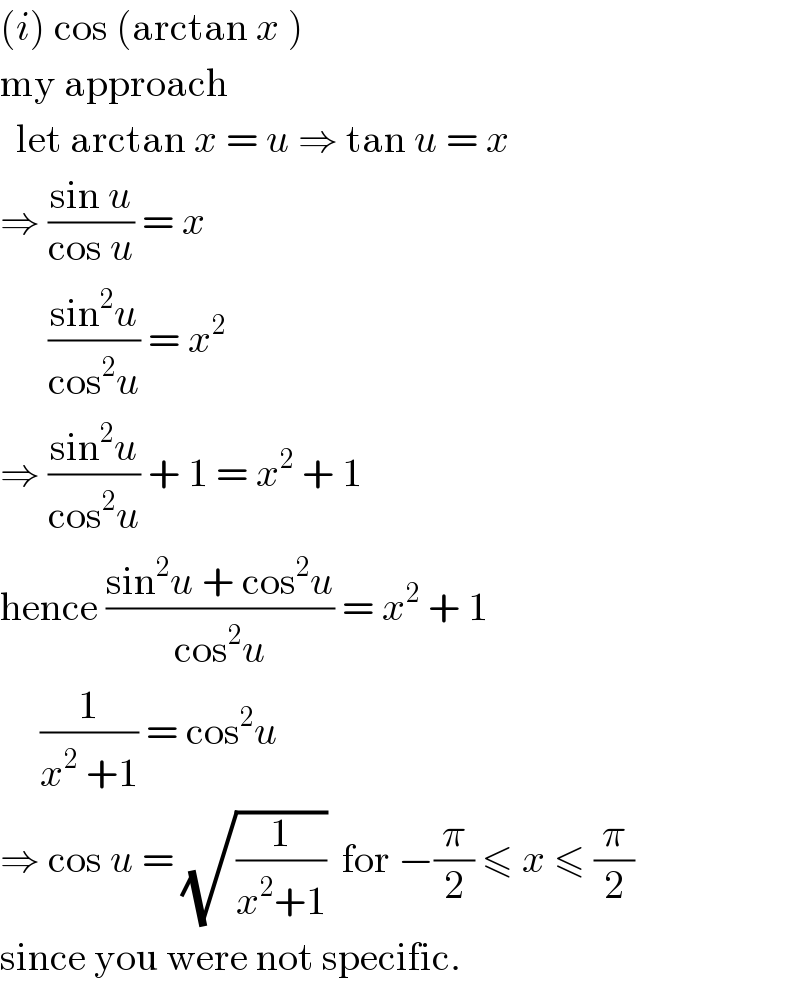Question Number 93239 by Ar Brandon last updated on 11/May/20

$$\mathrm{Calculate}; \\ $$$$\left.{i}\right)\:\mathrm{cos}\left(\mathrm{arctan}\:{x}\right) \\ $$$$\left.{ii}\right)\:\mathrm{cos}\left(\mathrm{arcsin}\:{x}\right) \\ $$$$\left.{iii}\right)\:\mathrm{tan}\left(\mathrm{arcsin}\:{x}\right) \\ $$
Commented by mathmax by abdo last updated on 12/May/20

$$\left.\mathrm{1}\right)\:{vhangement}\:{arctanx}\:={t}\:{give}\:{x}\:={tant}\:\Rightarrow \\ $$$${cos}\left({arctanx}\right)\:={cost}\:=\sqrt{\frac{\mathrm{1}}{\mathrm{1}+{tan}^{\mathrm{2}} {t}}}=\frac{\mathrm{1}}{\:\sqrt{\mathrm{1}+{x}^{\mathrm{2}} }} \\ $$$$\left.\mathrm{2}\right){let}\:{arcsinx}\:={u}\:\Rightarrow{x}\:={sinu}\:\Rightarrow \\ $$$${cos}\left({arcsinx}\right)\:={cosu}\:=\sqrt{\mathrm{1}−{sin}^{\mathrm{2}} {u}}=\sqrt{\mathrm{1}−{x}^{\mathrm{2}} } \\ $$$$\left.\mathrm{3}\right){let}\:{arcsinx}\:={u}\:\Rightarrow{x}\:={sinu}\:\Rightarrow{tan}\left({arcsinx}\right)\:={tanu} \\ $$$$=\frac{{sinu}}{{cosu}}\:=\frac{{sinu}}{\:\sqrt{\mathrm{1}−{sin}^{\mathrm{2}} {u}}}\:=\frac{{x}}{\:\sqrt{\mathrm{1}−{x}^{\mathrm{2}} }} \\ $$
Commented by Ar Brandon last updated on 12/May/20
Thanks Mathmax ��
Commented by mathmax by abdo last updated on 12/May/20

$${you}\:{are}\:{welcome}. \\ $$
Answered by hknkrc46 last updated on 12/May/20

$$\left.{i}\right)\:\mathrm{arctan}\:{x}={u}\:\Rightarrow\:\mathrm{tan}\:{u}={x}\:\wedge\:\mathrm{cos}\:{u}={h}=? \\ $$$$\mathrm{tan}\:{u}=\frac{\mathrm{sin}\:{u}}{\mathrm{cos}\:{u}}=\frac{\sqrt{\mathrm{1}−\mathrm{cos}\:^{\mathrm{2}} {u}}}{\mathrm{cos}\:{u}}=\frac{\sqrt{\mathrm{1}−{h}^{\mathrm{2}} }}{{h}}={x} \\ $$$$\Rightarrow\:\sqrt{\mathrm{1}−{h}^{\mathrm{2}} }={hx}\:\Rightarrow\:\mathrm{1}−{h}^{\mathrm{2}} ={h}^{\mathrm{2}} {x}^{\mathrm{2}} \\ $$$$\Rightarrow\:{h}^{\mathrm{2}} {x}^{\mathrm{2}} +{h}^{\mathrm{2}} =\mathrm{1}\:\Rightarrow\:{h}^{\mathrm{2}} \left({x}^{\mathrm{2}} +\mathrm{1}\right)=\mathrm{1} \\ $$$$\Rightarrow\:{h}^{\mathrm{2}} =\frac{\mathrm{1}}{{x}^{\mathrm{2}} +\mathrm{1}}\:\Rightarrow\:{h}=\frac{\mathrm{1}}{\:\sqrt{{x}^{\mathrm{2}} +\mathrm{1}}} \\ $$$$\left.{ii}\right)\:\mathrm{arcsin}\:{x}={u}\:\Rightarrow\:\mathrm{sin}\:{u}={x}\:\wedge\:\mathrm{cos}\:{u}=? \\ $$$$\mathrm{cos}\:{u}=\sqrt{\mathrm{cos}\:^{\mathrm{2}} {u}}=\sqrt{\mathrm{1}−\mathrm{sin}\:^{\mathrm{2}} {u}}=\sqrt{\mathrm{1}−{x}^{\mathrm{2}} } \\ $$$$\left.{iii}\right)\:\mathrm{arcsin}\:{x}={u}\:\Rightarrow\:\mathrm{sin}\:{u}={x}\:\wedge\:\mathrm{tan}\:{u}={h}=? \\ $$$${h}=\mathrm{tan}\:{u}=\frac{\mathrm{sin}\:{u}}{\mathrm{cos}\:{u}}=\frac{\mathrm{sin}\:{u}}{\:\sqrt{\mathrm{1}−\mathrm{sin}\:^{\mathrm{2}} {u}}}=\frac{{x}}{\:\sqrt{\mathrm{1}−{x}^{\mathrm{2}} }} \\ $$
Commented by Ar Brandon last updated on 12/May/20
hknkrc46 Thank you sir ��
Answered by Rio Michael last updated on 12/May/20

$$\left({i}\right)\:\mathrm{cos}\:\left(\mathrm{arctan}\:{x}\:\right) \\ $$$$\mathrm{my}\:\mathrm{approach} \\ $$$$\:\:\mathrm{let}\:\mathrm{arctan}\:{x}\:=\:{u}\:\Rightarrow\:\mathrm{tan}\:{u}\:=\:{x} \\ $$$$\Rightarrow\:\frac{\mathrm{sin}\:{u}}{\mathrm{cos}\:{u}}\:=\:{x} \\ $$$$\:\:\:\:\:\:\frac{\mathrm{sin}^{\mathrm{2}} {u}}{\mathrm{cos}^{\mathrm{2}} {u}}\:=\:{x}^{\mathrm{2}} \\ $$$$\Rightarrow\:\frac{\mathrm{sin}^{\mathrm{2}} {u}}{\mathrm{cos}^{\mathrm{2}} {u}}\:+\:\mathrm{1}\:=\:{x}^{\mathrm{2}} \:+\:\mathrm{1} \\ $$$$\mathrm{hence}\:\frac{\mathrm{sin}^{\mathrm{2}} {u}\:+\:\mathrm{cos}^{\mathrm{2}} {u}}{\mathrm{cos}^{\mathrm{2}} {u}}\:=\:{x}^{\mathrm{2}} \:+\:\mathrm{1} \\ $$$$\:\:\:\:\:\frac{\mathrm{1}}{{x}^{\mathrm{2}} \:+\mathrm{1}}\:=\:\mathrm{cos}^{\mathrm{2}} {u} \\ $$$$\Rightarrow\:\mathrm{cos}\:{u}\:=\:\sqrt{\frac{\mathrm{1}}{{x}^{\mathrm{2}} +\mathrm{1}}}\:\:\mathrm{for}\:−\frac{\pi}{\mathrm{2}}\:\leqslant\:{x}\:\leqslant\:\frac{\pi}{\mathrm{2}} \\ $$$$\mathrm{since}\:\mathrm{you}\:\mathrm{were}\:\mathrm{not}\:\mathrm{specific}. \\ $$
Commented by Ar Brandon last updated on 12/May/20
Thanks Mr Rio Michael. Good Day Sir ��
